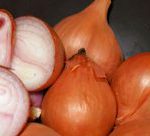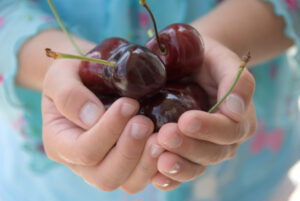Virgil Evetts
Where would we be without onions? This great and pungent clan of edible lilies is the back bone of practically every great cuisine. Just try to imagine a world without garlic, onions, leeks, spring onions or chives: a gourmand’s dystopian nightmare if ever there was one, and enough to make most of us want to fall on our boning knives. But it’s my guess that very few of us would even notice the passing of the shallot. For some sad reason this particular member of the great house of Allium is yet to have its day down under. My local supermarket treats them as some sort of quaint novelty – a measly couple of bulbs are offered under cling film on a spotless polythene tray and sold at prohibitive prices. Placed next to cheaper, free-flow onions it’s no surprise we tend to ignore them.
But despite the higher prices and piddley size the shallot is like the sexy cousin of the dumpy house-frau that is the common onion. Whereas onions are big and brash, the shallot is svelte and sophisticated with an understated charm.
In much of Europe, especially France, the shallot is treated with reverence and is used with intelligence and finesse. In Tropical Asia it replaces the onion altogether, being easier to grow in the dank, equatorial heat.
Shallots have a sweetness and fragrance that sets them far apart from even the best onions. They have a herbaceous, almost winey quality when cooked that may explain their slavish following in classical French cuisine. I can think of no more intoxicating fragrance in the kitchen than that of shallots slowly melting in butter. It’s quite hypnotic. Their gentle nature also makes them a great replacement for onions in salads. I detest raw onion in salads. More to the point, I detest raw onion in salads twelve hours later when I can still taste it in my mouth. Another tick in support of shallots – they still offer that savoury onion tang but none of the biting heat or lingering, sweaty after taste. But by all means stick with the tried and true raw onion if you must. Maybe you want to smell like a medieval Romanian peasant.
Practical matters
You can use shallots anywhere you would use onions as the star ingredient; for example French onion soup, that star of the 70s bistro scene, is totally the business when made with shallots. Caramelised shallots are also knee-tremblingly good, however you employ them, they’re sticky and sweet with a smart, rounded flavour that leaves your palate all a flutter.
South East Asian recipes specifying onion usually mean shallots. The true onion is barely known in the sweltering tropics, whereas shallots are grown and eaten in abundance. They are commonly softened in the stock base of soups such as tom kah gai and laksa, and are one of the core ingredients in Thai curry pastes. Indonesian and Malay satay – the highest form of the BBQ art -would be a far lesser dish without the traditional accompaniment of chopped raw shallot and cucumber. Local belief says that these two together counter the dangerous ‘heaty’ effects of the deliciously spicy, smoky meat on the body. In 30 degree heat and 100% humidity I can never tell the difference, but it sure tastes good.
I wouldn’t recommend using shallots in soffrito or mirepoix. They just don’t have the strength of character to hold their own against the thuggery of celery and carrots.
As I’ve mentioned, shallots are not cheap. Well not onion-cheap anyway, which isn’t really saying much. Onions are practically given away when you consider how long they spend in the ground and the laborious processes involved in harvesting and grading. How does anyone make money off the land?
Anyway, it is possible to have shallots without worsening the global financial crises; grow your own. They are less fussy than garlic and more productive than onions. If you’re not of a green-fingered persuasion you can buy them quite cheaply at Asian supermarkets. It’s an economy of scale thing I suppose, but Asian supermarkets usually offer shallots at far better price than your local musak-mart.
I know these are tough times and more than ever price dictates choice, but please promise me that you’ll refrain from buying [vastly inferior] Chinese garlic, out of season Californian onions or any other bargain basement allium imports. For a few cents more per kilo you will be rewarded with superior taste and texture, as well as the smug satisfaction that comes with local loyalty.
Shallot Pizza
You may have noticed that I have an ongoing obsession with Pizza. I make no apologies; it’s a great dish. The recipe below is a reverse-engineered rendition of a truly great pizza I ate in Rome a few years ago. To my taste, Roman pizza is usually better than that of Napoli, the home of pizza. There, I said it. Having now offended the honour of every loyal Camorra capo I’m probably on borrowed time now. So think of me while you partake of this pizza; it is, I rather fancy, like an edible ode to the silky, sweetness and fragrance that is the shallot.
1 tin tomatoes
2+ small dried chillies
Fresh Oregano to taste
2 strips [preferably free range] streaky bacon or pancetta affumicata
A good handful of peeled, sliced shallots
8 Kalamata olives
A good handful of grated Parmigiano, Grana Padano or similar [yes, generic parmesan is fine]
Olive oil
Optional extra: a few roughly strewn anchovy fillets work outrageously well here, but I appreciate that they’re something of an acquired taste.
Do I really need to give you a pizza base recipe? I think not. By all means make your own but to achieve the thin crispness that typifies Roman pizza, you may be better off with premade. I use the Turkish Bread brand but I’m sure there are others out there. Either way, start by preheating your oven to its maximum temperature. Preferably use a pizza stone or inverted cast-iron skillet.
To make the sauce, drain and gently squeeze the tomatoes. Blend with the chillies, oregano, a good glug of oil and season to taste.
Spread the sauce evenly over the base. Sprinkle the cheese evenly over top, followed by the bacon [roughly chopped].
Toss the sliced shallots in a little olive oil [This helps them to cook quickly without burning] before continuing as above.
Arrange the olives evenly around the pizza, dress with a little more oil and shoot into the oven.
Cooking time will depend on temperature but the pizza should be done in about 10-15 minutes. Eat sizzling hot with someone you like.
French Shallot Soup
I can remember the first time I had French onion soup as a child. It was in a dark basement bistro somewhere off Queen Street, I couldn’t tell you exactly where or when but it seemed like a very grown up sort of place and a very grown up dish. The deep, complex flavours of the, steaming soup are perfectly paired with the crispy raft of the gruyere crouton. Forget chicken soup, this is the real soul food.
1 litre+ strong, REAL beef stock
Enough sliced shallots to fill a 1 litre jug [I never said this would be cheap]
A lot of butter [at least 3 or 4 tablespoons full]
Gruyere cheese
Crusty, fresh baguette
¼ cup dry sherry
A bay leaf or two
Brown sugar
In a heavy pot on a medium heat melt the butter. When sizzling, add the shallots and slowly and attentively cook down until they begin caramelise. This takes no less than 20 minutes. The slower you cook them the better the end result. The trick with caramelizing onions etc is to use a low steady heat. Don’t let them stick, don’t let them burn. When caramelisation begins [the shallots will be a dark tan colour and quite sticky] add about a tablespoon of brown sugar and stir a little longer. Add the boiling stock and the bay leaves and allow to simmer uncovered for about half an hour. Add the sherry and simmer for another 10 minutes. Adjust seasoning to taste. At this point the soup should be very rich with a strong beef/shallot flavour and winey/sweet undertone.
Traditionally at this point the soup is plated, the slice of baguette is placed on top, the gruyere on top of that and the whole thing goes under a flaming grill. I can’t be doing with this. It leaves the bowl white-hot and the crouton soggy underneath so…
Slice the bread thickly, drizzle with melted butter and grill on one side. Now generously sprinkle grated gruyere on the ‘raw’ side and grill again until the cheese is sizzling and fragrant.
Serve with or on top of the soup. It’s up to you.
Enjoy, and that’s an order.





This is a very good article. Thank you for a great information.
I can acquire knowledge in this artilce. Thank you.
I’ve been using shallots for years in place of onions at various times. They are fabulous in home made chiken liver pate in place of onion. I add them peeled and whole to the slow cooker and when ready to serve the meat some 8 hours later take them out, mash them a wee bit, and add them to the mashed potato which gives it a nice bistro look and flavour. Also they are lovely roasted along with roasted garlic.
To answer your question about Shallots. As a general rule NZ does not import Shallots. We have only ever heard of it once in 2006 when there was an almost total crop failure here.
Our company supplies Shallots year round to the supermarkets as does one other Marlborough grower.
Time of planting is critical as are daylight hours when bulbing.This is also specific to variety.
Shallots & Onions are very susceptible to Insect damage particularly Thrips and are subject to attack by fungi such as Powdery Mildew.All things to look out for when growing.
Great article. I hope your article creates a greater demand or them and brings the price down. I too find the ad-hoc nature of their availability frustrating. Next month I am going to start building a raised veggie garden. This will be the first time I will ever had a veggie garden. I hope they are easy to grow as they are on my list of ‘would like to grow’.
Thanks Gaye.
That’s very interesting. I only ever buy local garlic. Even if it wasn’t an ethical choice I wouldn’t bother with the Chinese stuff because it lacks a true garlic flavour. I’d like to say that I only buy local shallots but I’m just not sure. Do we import shallots into NZ? If so are there any tell-tale signs like the removal of roots and the bleached skin on Chinese garlic?
Great to hear from some actual growers and I urge the rest of you to support them buy only buying locally grown onions, garlic and shallots.
Virgil
Speaking from the perspective of a commercial grower, I can confirm that shallots are an extremely expensive crop to grow. Seed cost alone is in excess of $13000 P/Hectare. Our seed is imported annually from Holland,from a company which has sole world wide distribution rights.
There is no way around this since true seed is grown by only one company in the world.
As a large commercial operator we aim to provide value to consumers. You should be able to find our Shallots and Garlic in your local supermarket,both loose and prepack. There is no denying that shallots are more costly than onions,but there really is no comparison from a cost of production perspective.
I hope this gives some insight for shallot aficionados.
I use pickling onions in Bœuf bourguignon. Just lovelly.
Agreed!
shallots do have quite a different look to them also so you will be able to tell them apart after some careful investigation. Pickling onions are great though for those wonderful winter slow cooked casseroles. Peel them and pop them in whole.
In my experience pickling onions are simply a small grade of brown onion. It would be a very poor economy to use shallots in this way and they dont really have the right flavour for pickling anyway.
Virgil,
May i ask. Can stores advertise Shallots as pickling onions?
Or are they a differen type of thing.
My pleasure Sally.
In researching this piece I have found a renewed love for shallots- so much more interesting than most onions. I fear you are probably one of the few commercial growers left in NZ. I do hope this tide turns and wish you every success.
Thank you so much for this profile, my husband and I have this year grown our first commercial crop of shallots (and small onions for pickling & gourmet use). We have been selling them locally at our Farmers Market and the likes for the past month. Last weekend we were overjoyed at how many folks were repeat purchasing and saying how much they were loving the product. Many had purchased the shallots knowing that they had seen them in recipes but never made the effort or had the opportunity to buy them. They are a lost jewel. Buy a storing variety like matador and enjoy them for the best part of the year. Enjoy a healthy flavoursome vegetable. Kind Regards Sally